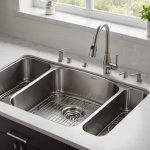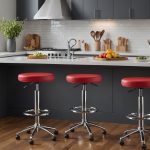Overview of Kitchen Sink Importance for Health-Savvy Cooks
For the health-conscious cook, the kitchen sink is pivotal in maintaining culinary hygiene. It’s not just a vessel for washing dishes or rinsing vegetables; it’s a hub for hygienic cooking practices. A well-maintained sink can significantly reduce the risk of cross-contamination, ensuring that your kitchen remains a safe environment for preparing healthy meals.
A stylish sink does more than just improve functionality; it enhances your kitchen’s aesthetic. The right sink design can transform your cooking space, making it both inviting and efficient. Modern kitchens integrate sinks with contemporary styles and colours that complement an array of décor themes, balancing between practicality and visual appeal.
This might interest you : Discover the Perfect Kitchen Stool: Key Ergonomic Features for Enhanced Posture and Digestion
The health-centric features of today’s kitchen sinks extend beyond their basic utility. Advanced models now include anti-microbial coatings, designed to prevent bacterial growth. These sinks often have deep basins that accommodate large pots and reduce splashing, contributing to a cleaner kitchen. These features are crucial for those who prioritize health in their cooking routines, as they facilitate a cleaner and more organised kitchen setup, significantly reducing food safety concerns. Understanding these aspects helps cooks choose the best sink to meet their culinary hygiene needs.
Stylish Kitchen Sinks That Enhance Aesthetics
The modern kitchen has evolved into a blend of functionality and style, and a stylish kitchen sink can truly transform this space. Design trends now emphasize sleek and minimalist designs that align with kitchen aesthetics, adding both beauty and efficiency.
Topic to read : Ultimate Meal Planning Mastery: Your All-Inclusive Guide to Creating a Seamless Kitchen Hub for Optimal Dietary Success
Current Design Trends in Kitchen Sinks
Today’s kitchens celebrate individuality, with sinks playing a pivotal role in this stylistic shift. Stylish kitchen sinks showcase trends such as integrated draining boards and low-profile edges. These features not only improve usability but also contribute to a clean, streamlined look. Some kitchen designs even combine sinks with cutting-edge tech like touchless faucets, offering an elegant marriage of form and function.
Popular Materials for Aesthetic Appeal
Incorporating materials that blend durability with visual allure is crucial. Stainless steel remains a favourite for its timeless appeal and resilience. Meanwhile, stone composite sinks are gaining traction, offering a charming rustic look to the kitchen. These materials provide not only an improved aesthetic but also practicality, as many are designed for easy maintenance, aligning with health-conscious uses.
Functional Features for Health-Conscious Cooking
Functional kitchen sinks are designed to support health-conscious cooking by focusing on crucial features like easy-to-clean materials and ergonomic designs. These elements are not merely conveniences; they’re central to maintaining a germ-free kitchen environment. Easy-to-clean materials are paramount in preventing bacteria build-up. For example, stainless steel and quartz are popular choices due to their non-porous surfaces, which resist bacterial infiltration and are simple to sanitise.
In addition to materials, ergonomic designs have become essential. A well-designed sink eases the strain of meal prep and cleanup. Deep basins, for instance, accommodate larger pots and utensils, minimising spills and splashes that can lead to mess and bacteria proliferation. This feature also supports water conservation by efficiently directing water flow.
Furthermore, many modern sinks include antimicrobial coatings that actively inhibit bacterial growth. This means that even between thorough cleanings, your sink remains a more hygienic component of your culinary setup. These functional aspects not only enhance the utility but also align with the health-focused needs of contemporary cooks. With these features, sinks become not just utilities but integral parts of a clean and efficient kitchen.
Product Comparisons of Top Kitchen Sinks
Selecting the right kitchen sink involves weighing factors that cater to both functionality and aesthetic appeal. With myriad options available, evaluating the distinction between multi-function sinks and traditional sinks is a fundamental step. Multi-function sinks often feature integrated accessories like chopping boards and colanders, providing enhanced convenience during meal preparations. Conversely, traditional sinks, while simpler, may appeal to those who prefer a classic kitchen layout.
Best Sinks for Small and Large Kitchens
When considering kitchens of varying sizes, the right sink size and design can significantly impact usability. For smaller spaces, compact yet deep sinks maximise functionality without overcrowding the area. Large kitchens can accommodate more elaborate setups, such as double-basin or farmhouse sinks, which support substantial cooking activities.
Analysis of User Ratings and Reviews
Evaluating user ratings provides insight into real-life applications and satisfaction levels. Sinks with positive feedback often highlight reliability, ease of cleaning, and the inclusion of health-focused features such as antimicrobial coatings. On the contrary, less favorable reviews may point towards issues like durability or installation difficulty, guiding potential buyers in making informed decisions. Understanding these comparisons helps users align their choices with their kitchen aesthetics and hygiene priorities.
Installation Tips for Kitchen Sinks
Ensuring a smooth sink installation process involves understanding both DIY tips and when to resort to professional help. For those considering a do-it-yourself approach, a step-by-step guide can prove invaluable.
Begin by ensuring all necessary tools and components are on hand to avoid interruptions. Carefully read the manufacturer’s instructions and align the sink with the pre-cut hole to check for a secure fit. Apply a continuous bead of plumber’s putty around the edge to prevent leaks, then secure the sink with clips beneath the countertop.
Common mistakes, such as neglecting to seal properly or over-tightening, can lead to complications like leaks or damage to the countertop material. Consulting online guides and videos beforehand can clarify the process and highlight additional DIY tips.
Despite best efforts, certain installations may demand professional expertise. If working with heavy or delicate materials—or tackling complex plumbing connections—it might be wise to engage a professional. They provide assurance and often result in more polished finishes.
Consider the type of sink and its features when deciding between DIY and professional installation. Kitchens with sophisticated setups, like those with integrated drainage, may benefit from skilled installation to ensure full functionality.
Maintenance for Longevity and Hygiene
Understanding the essentials of sink maintenance is key to preserving both the longevity and hygiene of kitchen sinks. With regular upkeep, a sink can remain both a visual centrepiece and a bastion of cleanliness in the kitchen environment.
Choosing effective cleaning products tailored to specific sink materials enhances hygiene. For stainless steel, non-abrasive cleaners are ideal to avoid surface scratches. Stone composite or ceramic sinks may benefit from a gentle cleanser or a mix of vinegar and baking soda to eliminate bacteria without harmful chemicals. Using the appropriate product prevents damage and maintains a clean, germ-free environment.
Routine maintenance is as crucial as cleaning. Regular checks for drainage functionality and leak prevention should be performed. Simple steps like ensuring that drain traps are clear and inspecting seals for damage can avert larger problems. Routine checks help in maintaining the integrity and efficiency of the sink’s daily use.
Lastly, introducing a habit of wiping down the sink after each use can prevent water spots and bacterial accumulation. These hygiene tips aid in preserving the sink’s appearance and function, promoting a healthier cooking space. With thoughtful maintenance, kitchen sinks remain both practical and visually appealing for years to come.
User Testimonials and Real-Life Applications
Understanding the real-life applications of kitchen sinks through user testimonials provides valuable insight into their usability and impact on health-focused cooking. Health-savvy cooks have witnessed transformative experiences by integrating well-designed sinks into their kitchens.
Case Studies from Health-Savvy Cooks
In several case studies, users have highlighted how specific features of their sinks have elevated their culinary hygiene routines. For example, many found that antimicrobial coatings actively reduced bacterial growth, ensuring a cleaner cooking environment. Others noted that deep basins facilitated easier cleaning and food preparation, reducing mess and risk of contamination.
Benefits Experienced by Users
Users have consistently reported enhanced satisfaction due to the balance between kitchen aesthetics and functionality in their sinks. Stylish designs that incorporate durable materials not only enhance visual appeal but also offer practical solutions for health-conscious cooking. The ease of cleaning and ergonomic design often result in reduced fatigue and improved efficiency during daily meal prep.
Visual Examples of Sinks in Use
Real-life examples showcase the practical use of kitchen sinks. Images and videos from users illustrate varied setups, from compact urban kitchens to expansive, rustic kitchens. These visuals inspire others by demonstrating how a thoughtfully chosen sink becomes central to a practical and health-oriented kitchen setup.











